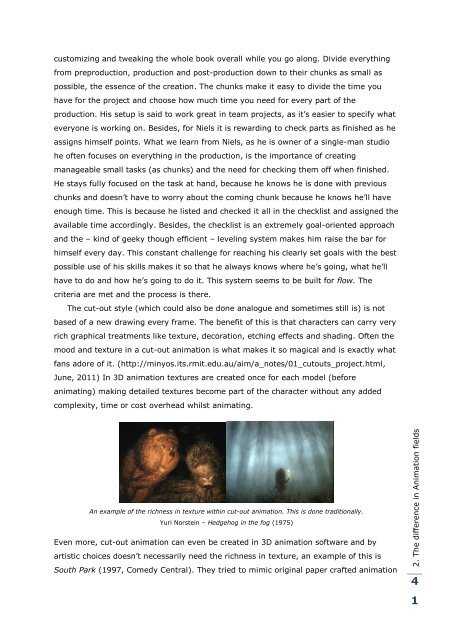Release. Pressure. Animate.
Release. Pressure. Animate.
Release. Pressure. Animate.
Create successful ePaper yourself
Turn your PDF publications into a flip-book with our unique Google optimized e-Paper software.
customizing and tweaking the whole book overall while you go along. Divide everything<br />
from preproduction, production and post-production down to their chunks as small as<br />
possible, the essence of the creation. The chunks make it easy to divide the time you<br />
have for the project and choose how much time you need for every part of the<br />
production. His setup is said to work great in team projects, as it‟s easier to specify what<br />
everyone is working on. Besides, for Niels it is rewarding to check parts as finished as he<br />
assigns himself points. What we learn from Niels, as he is owner of a single-man studio<br />
he often focuses on everything in the production, is the importance of creating<br />
manageable small tasks (as chunks) and the need for checking them off when finished.<br />
He stays fully focused on the task at hand, because he knows he is done with previous<br />
chunks and doesn‟t have to worry about the coming chunk because he knows he‟ll have<br />
enough time. This is because he listed and checked it all in the checklist and assigned the<br />
available time accordingly. Besides, the checklist is an extremely goal-oriented approach<br />
and the – kind of geeky though efficient – leveling system makes him raise the bar for<br />
himself every day. This constant challenge for reaching his clearly set goals with the best<br />
possible use of his skills makes it so that he always knows where he‟s going, what he‟ll<br />
have to do and how he‟s going to do it. This system seems to be built for flow. The<br />
criteria are met and the process is there.<br />
The cut-out style (which could also be done analogue and sometimes still is) is not<br />
based of a new drawing every frame. The benefit of this is that characters can carry very<br />
rich graphical treatments like texture, decoration, etching effects and shading. Often the<br />
mood and texture in a cut-out animation is what makes it so magical and is exactly what<br />
fans adore of it. (http://minyos.its.rmit.edu.au/aim/a_notes/01_cutouts_project.html,<br />
June, 2011) In 3D animation textures are created once for each model (before<br />
animating) making detailed textures become part of the character without any added<br />
complexity, time or cost overhead whilst animating.<br />
An example of the richness in texture within cut-out animation. This is done traditionally.<br />
Yuri Norstein – Hedgehog in the fog (1975)<br />
Even more, cut-out animation can even be created in 3D animation software and by<br />
artistic choices doesn‟t necessarily need the richness in texture, an example of this is<br />
South Park (1997, Comedy Central). They tried to mimic original paper crafted animation<br />
2. The difference in Animation fields<br />
4<br />
1


